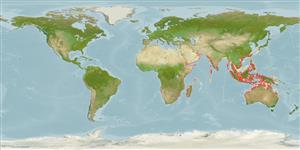Classificação / Names
Common names from other countries
Referência principal
Tamanho / Peso / Idade
Max length : 90.0 cm TL macho/indeterminado; (Ref. 5284); common length : 40.0 cm SL macho/indeterminado; (Ref. 9772); Peso máx. publicado: 7.0 kg (Ref. 9987)
Length at first maturity
Lm 22.6 range ? - ? cm
Ambiente
; marinhas; estuarina bentopelágico; anfídromo (Ref. 51243); intervalo de profundidade 10 - 40 m (Ref. 9772)
Clima / Intervalo
Tropical; 26°C - 29°C (Ref. 4959), preferred 27°C (Ref. 107945); 34°N - 35°S, 20°E - 154°E
Distribuição
Indo-West Pacific: East Africa, including Madagascar (absent in the Red Sea), eastward to southern China Sea and Queensland, Australia.
Países | Áreas FAO | Ecossistemas | Ocorrências | Introduções
Descrição breve
Espinhos dorsais (total): 10 - 11; Raios dorsais moles (total): 27-30; Espinhos anais 2; Raios anais moles: 7 - 8
Categoria na Lista Vermelha da IUCN (Ref. 115185)
Ameaça para o homem
Harmless
Utilização humana
Pescarias: espécies comerciais; peixe desportivo: sim
Mais informação
ReferênciasAquaculturaPerfil para aquaculturaEstirpesGenéticaFrequência dos alelosHereditariedadeDoençasProcessamentoMass conversion
ColaboradoresFotografiasStamps, CoinsSonsCiguateraVelocidadeTipo de nataçãoÁrea branquialOutras referênciasCérebrosVisão
Ferramentas
Relatórios especiais
Descarregue XML
Fontes da internet
Estimates of some properties based on models
Phylogenetic diversity index
PD50 = 0.7500 many relatives (e.g. carps) 0.5 - 2.0 few relatives (e.g. lungfishes)
Nível Trófico
3.6 ±0.6 se; Based on diet studies.
Resiliência
Médio, tempo mínimo de duplicação da população 1,4 - 4,4 anos (K=0.14-0.41; tm=1; tmax=5; Fec= 53,676)
Vulnerabilidade
Moderate vulnerability (37 of 100)
Categoria de preço
